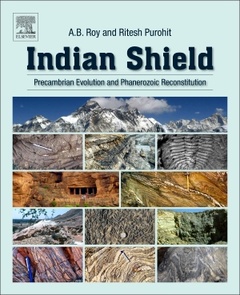Description
Indian Shield
Precambrian Evolution and Phanerozoic Reconstitution
Authors: Roy A.B., Purohit Ritesh
Language: English
Subject for Indian Shield:
398 p. · 19x23.3 cm · Paperback
Description
/li>Contents
/li>Readership
/li>Biography
/li>Comment
/li>
Indian Shield: Precambrian Evolution and Phanerozoic Reconstitution highlights unique evolutionary trends covering a period of over 3,500 million years, from the oldest crust to the most recent geological activity of the Indian Subcontinent. The book discusses regional terrain geology in terms of the evolutionary history of the crust, describing how the Precambrian Shield evolved from a stable continental region to a tectonically unstable zone marked by frequent high-intensity earthquakes in a Plate-interior setting. It is a complete and readable account of the history of growth and evolution of the Indian Subcontinent, including Bangladesh, Bhutan, India, Nepal and Pakistan.
The book is intended for graduate students, researchers, and teachers in the geosciences, especially geophysics, geomorphology and geology. The book also serves as an important resource for tectonics and petrology researchers, as well as those involved in exploration of mineral resources.
PART 1: Precambrian Crust of India: A general Introduction1. Pristine size, shape and tectonic framework of Indian Shield2. Geomorphotectonic and Geophysical characterization of Indian Subcontinent3. Framework of Indian Shield: Concepts and tectonic subdivisions4. Geology and evolutionary history of Precambrian crustal blocks5. Correlation and evolutionary history of the Indian Shield
PART 2: Early Phanerozioc Geology of India6. Palaeozoicgeologic history7. Geology of the Gondwana Supergroup: 1. Definition, Classification, and Distribution8. Geology of the Gondwana Supergroup: 2. Sedimentation, Basin Morphology and Evolution
PART 3: Between Jurassic Breakup and the Himalayan Collision9. Jurassic marine incursions and basin evolution10. Development of fracture system (Lineament) consequent on break-up of Gondwanaland11. Plume outbursts and their manifestations on Indian Shield
PART 4: Geology and Evolution of the Himalayas12. Constituents and Tectonic architecture of the Himalayas13. Lithotectonic Units and Sedimentation pattern14. Pattern of metamorphism and Tectonichistory of the Himalayas
PART 5: Quaternary Geology and Active tectonics and Palaeoseismicity15. Quaternary Basin evolutions and sedimentation pattern16. Active tectonics and resultant seismicity in Indian Subcontinent
Geologists, Geomorphologists, Geochemists, Mineralogists, Petrologists and Geophysicists
Ritesh Purohit, MSc (1995); PhD (2002) (ML Sukhadia University) is an Associate Professor in Geology at the Government College, Sirohi, Rajasthan, India. He has been engaged in teaching and research for the last 22 years and has more than 100 research publications to his credit. He is involved in many international research collaborations including the Carnegie Institution of Washington, USA. He is a recipient of post-doctoral research awards from UGC and DST of the Govt. of India, and grants from NASA, International Atomic Energy Agency, Geological Society of America, International Geological Congress and UNESCO-IGCP for research activities.
- Features comprehensive geological information on the evolution of the Indian Subcontinent, from the growth of early crust to the present day in a single volume
- Discusses different processes of post-Precambrian reconstitution of the Indian Shield that ultimately produced the present-day geomorphology as well as the tectonic character of the region
- Assesses the impacts and effects of the ongoing post-Himalayan tectonism on the Indian Subcontinent

